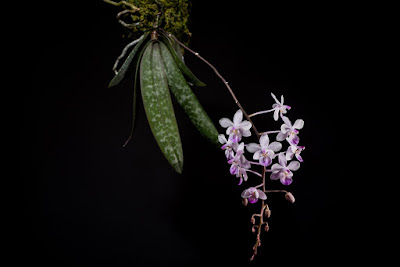Linden's Phalaenopsis is native to Benguet and Baguio in the northern part of the island of Luzon in the Philippines at an altitude of around 1500 m or higher. Its natural habitat is subtropical or tropical moist lowland forests.
Phalaenopsis lindeni orchid, also called as Linden's Phalaenopsis (named after Belgian botanist Jean Jules Linden), is a species of the genus Phalaenopsis. This species was described by Loher in 1895.
IDENTIFY PHALAENOPSIS LINDENI ORCHID
Linden's Phalaenopsis is native to Benguet and Baguio in the northern part of the island of Luzon in the Philippines at an altitude of around 1500 m or higher. Its natural habitat is subtropical or tropical moist lowland forests.
It is a smaller sized, cool, pendant growing epiphytic species with a very short stem enveloped by imbricating leaf bases carrying oblong-lanceolate, to oblong-oblanceolate, acute or obtuse and unequally bilobed apically, dark green mottled with silver-white leaves. The leaves are up to 25 cm long.
Phalaenopsis lindeni blooms from the spring through fall on a lateral, slender, racemose or rarely paniculate, densely many (30 to 40) flowered, inflorescence that has a flexuose rachis with small bracts and simultaneously opening, delicate flowers. The flowers are 2.5-3.8 cm in diameter and very nice, delicate, they can be white, with different shades of pink, or pale colored. On the petals of both whorls there is a small number of pink dots at the base. A disproportionately large lip with an amethyst color has white side plots and may have 5-7 radially spaced dark pink or red stripes. Certain segments may also be ribbed.
GROW AND CARE PHALAENOPSIS LINDENI ORCHID
Cultural information should only be used as a guide, and should be to be adapted to suit you. Your physical location; where you grow your plants, how much time you have to devote to their care, and many other factors, will need to be taken into account. Only then can you decide on the cultural methods that best suit you and your plants.
Light:
Phalaenopsis linden needs a light level of 10,000-12,000 lux and keep in partial shade.
Temperature:
It is plant with moderate thermal requirements. In summer, the average day temperature is 22-24 ° C, the average night 16 ° C, which gives a daily difference of 6-8 ° C. In winter, the average day temperatures are 22-24 ° C, and the night 13-15 ° C, with an amplitude of 9-10 ° C. This plant does not tolerate excessive heat, and is usually grown at too high temperatures together with other species of this type and as a result is considered difficult.
Humidity:
This species needs the humidity of 80-90% throughout the year.
Substrate, growing media and repotting:
Phalaenopsis lindeni can grow in pot with 12-16 mm pieces of fir bark as substrate. Repotting is best done just after flowering, or when the growth of new roots begins.
Watering:
In the period of active growth, the plants should be constantly moist, because rainfall in the natural habitat during this period are very abundant.
Fertilizer:
In the period of active growth, it is recommended to apply once a week or once every two weeks 1/4-1/2 of the recommended dose of fertilizer for orchids.
Rest period:
A two-month resting period in winter is recommended. The amount of water should be limited to light watering only every 2-3 weeks and occasional fogging between watering, but on condition that high humidity is maintained. Do not let the plants dry up completely. To start the growth of new increments, plant fertilization should be limited or completely discontinued.















COMMENTS